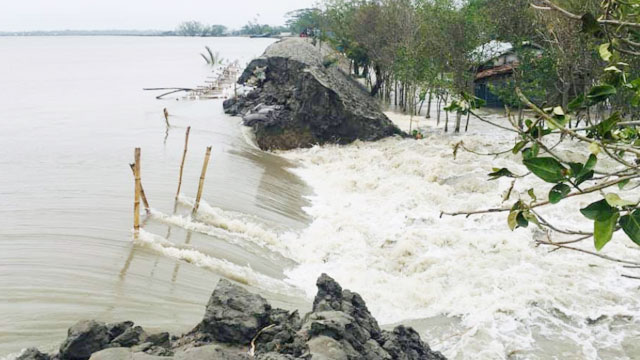At least 17 people were killed as super cyclone Amphan battered 26 coastal and northern districts with hurricane strength winds for 15 hours from Wednesday afternoon to Thursday morning.
The affected districts lay in ruins with thousands of houses and other infrastructures such as bridges and government offices damaged and vast agricultural land either levelled or inundated when the storm turned into a depression around 9:00 am Thursday.
The super cyclone weakened after making landfall in the coastal region of West Bengal in India near the Bangladesh border and moved across the shores of the two countries, it left a swathe of destruction.
Hundreds of tress, electricity poles and cell towers were uprooted and shattered and mango and banana orchards were also affected in south-western and northern districts.
As people left the cyclone shelters, where about 24 lakh people had been evacuated, they struggled to make their way back home with roads badly damaged or flooded with water and floodwater still gushing through dozens of breaches made in the coastal protection embankments.
‘Primarily, we estimate the total loss to be around Tk 1,100 crore,’ said Enamur Rahman, state minister, disaster management and relief, in an online press briefing in the afternoon.
He said that the cyclone killed at least 10 people including a volunteer of cyclone preparedness programme though the health control room already confirmed 16 deaths in nine districts.
‘The damages would have been greater had the cyclone not crossed over the Sunderbans before hitting the coastal villages,’ Bangladesh Meteorological Department director Shamsuddin Ahmed told New Age.
The centre of the cyclone first tracked through the Sunderbans with the sustained winds of more than 160 km per hour gradually losing strength before it hit villages in Satkhira, he said.
The destruction the cyclone caused in West Bengal after making its landfall was rather much higher because it landed directly on the coast and reached villages with full strength, he said.
The disaster minister said that the coastal districts Satkhira, Bagerhat and Patuakhali were the worst affected areas.
He admitted that there were some districts such as Rajshahi, Kushtia, Meherpur, Jashore and Magura where the cyclone hit without the government alerting them of the approaching super cyclone beforehand.
The highest number of five people, three of them women, died in Jashore after being crushed under trees while two each died in Bhola, Pirojpur and Patuakhali and one each in Barishal, Barguna, Sathkhira, Jhenaidah and Chattogram.
The deaths mostly occurred after people were crushed under trees and other causes, included drowning, boat capsizes, stroke and wall collapse, according to the health control room.
The cyclone damaged 1,100 km roads in the affected districts, said the minister, adding that there were 200 bridges and culverts and 233 local government officer that were also damaged in the cyclone.
The cyclone damaged many deep tube wells for which the government had to make emergency alternative arrangements such as supplying drinking water in jerrycans or in truck-mounted water tanks, said the minister.
Crops, vegetables and fruits such as jute, mango, bananas and mug beans were damaged in the cyclone, he said.
‘The losses in mango production would be around Tk 150 crore,’ said Enam.
‘Shrimp enclosures worth Tk 350 crore were also damaged in Satkhira and Bagerhat,’ he said.
The coastal protection embankment was breached in at least 84 places which would require Tk 300 crore to be repaired, he said.
The minister could not immediately give an account of the number of houses damaged in the cyclone for there were too many of them and said that it would take a week to fully assess the damage.
‘The repairing and rebuilding would start in the next 24 hours,’ said the minister.
Rural Electrification Board said that over 10 million people in 41 districts were without power after the roaring winds of the cyclone extensively damaged their distribution network.
‘Power supply will be restored to more than half the affected people by tonight,’ said REB member Anjan Kanti Das.
The cyclone Amphan started to enter Bangladesh as a very severe cyclonic storm around 4:00pm with wind blowing up to 150 km per hour or above at some places such as Satkhira and Jashore.
The cyclone also pushed water as high as 15 feet above the normal astronomical tides with all coastal rivers overflowing and even coastal towns going under several feet of water by midnight.
New Age correspondent in Barishal reported that the cyclone damaged 60 thousand houses in the division and 90 per cent of boro cultivated on 1.25 lakh hectares were damaged.
New Age correspondent in Khulna reported that over 5,600 families were marooned after breaches in costal embankment caused the flooding of 12 villages at Koyra.
He reported that more than 86,000 houses were damaged there.
New Age correspondent in Jashore reported that 25 people were injured in the district.
This is the second time a super cyclonic storm was formed in the Bay of Bengal since 1999, when the cyclone category was first introduced after an unusually strong cyclonic storm formed, which eventually killed 10,000 people in Odisha.
As Amphan made landfall in Odisha, international media until Thursday evening confirmed the death of 76 people in West Bengal.
The wind speed reached 260 km per hour when the storm system reached its peak on Monday but it lost some strength afterward before making landfall.
‘Amphan’s impacts on the Sunderbans was not yet clear but tidal surges turned all the 80 sweet water ponds in the forest saline,’ said Moyeen Uddin Khan, conservator of forests, Khulna.
New Age correspondent in Sirajganj reported that a 38-year-old man, Delsat Ali, was caught in the storm as he was riding a motorbike at about 10:00pm at Kazipur union on Wednesday.
The health control room said that the death figure was likely to go up as they could not reach people in many areas over phone.





